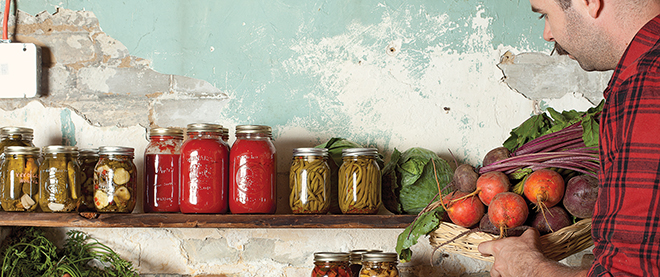Latest foodie trend: building a root cellar
Today’s basements are too hot for preserves and vegetables
Photograph by Reena Newman
Share

When Marla MacLeod and her partner, both Halifax homeowners, moved in together, they had a hard time settling on whose house to live in. Only one, however, had a cinder-block root cellar. It was one of the reasons they picked his place.
“We used it for the first time last winter and it was great,” she says. “I bought about $150 worth of root vegetables, apples and cabbage, and I was still eating beets in late April.”
MacLeod is one of many people who are taking their locavore inclinations one step further, installing functional cold rooms in buildings that never had them.
“People’s basements are too hot now. It’s not like before, when your basement was just a natural root cellar,” says Alison Fryer of the Cookbook Store in Toronto, who frequently encounters people looking for books on how to build one. “There’s this whole renewed interest in pickling and preserving, and that raises the problem of where you are going to store all of it.”
Before the advent of home refrigeration, root cellars were the only way most Canadians could ensure a fresh food supply in winter and early spring, as produce stored outside quickly rotted once brought inside. Elliston, Nfld., is the self-branded root cellar capital of the world, with more than 130—some dating back to 1839—dug into the earth.
While Peterborough, Ont., food writer Jennifer MacKenzie says her specialties are canning and preserving, she jumped at the chance to write recipes for The Complete Root Cellar Book.
“It’s really fascinating, because it’s not something that people were talking about for a while. Then when we came out with the book, everyone was like, ‘Oh yeah!’ ” The boom in urban farmers’ markets is behind the demand, says MacKenzie, as city-dwellers splurge on big boxes of fresh produce and quickly realize they need a way to process and store all of it.
Construction expert Steve Maxwell, MacKenzie’s co-author, says most cold rooms aren’t built properly and need important modifications before they can be used for vegetable storage. Ideal temperature and humidity levels vary for different kinds of produce, but the best space is dark, well-ventilated and between 1 and 10° C, with humidity between 80 and 95 per cent. The low temperature slows the release of ethylene gas, which causes ripening, and the high humidity prevents transpiration, or moisture loss, in root vegetables, thicker-skinned fruits and many aromatics. “All you need to do is create a cool, moist space. That can happen in something as small as an old fridge, or it can happen in a backyard pit, in a basement, or in any electrically assisted space,” Maxwell says.
In Halifax, MacLeod led a project to build a community root cellar in the dirt-floor basement of her employer, the non-profit Ecology Action Centre. Five people (with partners, children and roommates at home) ordered 220 kg of food for a grand total of $370. The centre has since given out five $400 grants to non-profits across Nova Scotia to build more community root cellars.
Inspired by her parents’ cold room, St. John’s, musician Evelyn Osborne has decided to build one in her basement. Her cousin framed the room this year, and now she needs to insulate it and install proper ventilation—which means punching a hole in the concrete foundation. “There’s definitely a romanticism around canning and preserving, and of course root cellars are coming back in vogue,” she says. “But canning is something you can do in an afternoon. Constructing something in your basement or out in the yard is quite a bit more work.”
The room is a natural next step in an effort to be less dependent on imported food when trucks from the mainland don’t make it to Newfoundland during the winter, and to eat more local produce.
“If you want to eat locally and support local farmers you have to buy in bulk in the fall, and then you need a way to store it because you don’t want 50 lb. of potatoes going off. There’s nothing worse than a rotten potato.”